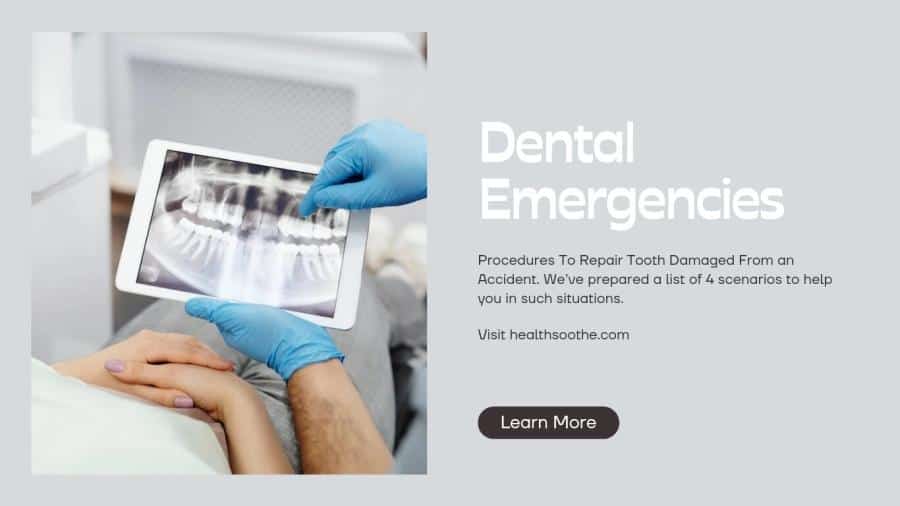There is always Medical emergencies in dental practice such as sudden Collapse, Shock, Hypoglycemic and hyperglycemic coma, Asthmatic attack, Anaphylaxis. and during surgical procedure too.
That is while in dentistry, dentists and dental public health are capable and specialize to handle any dental emergency and a dental problem that may arise within.
At Dental clinics, every effort has been made in case of an accident and you want to see a dentist right away. Waiting for 2 or 3 days in pain is not good at all. So, Dental association provides medical emergencies in dental practice in most of the countries to handle all types of dental mishaps.
What are Medical emergencies in dental practice?
Medical emergencies is a medical condition that requires immediate or urgent attention. Medical emergencies in dental practice are relatively rare in dental health care, but all effort has been made to prevent its occurrence.
What are the common medical emergencies in dental practice?
- Syncope / collapse.
- Shock
- Hypoglycemic/hyperglycemic coma.
- Asthmatic attack.
- Anaphylaxis.
How Can You Reach Your Dentist in Case Of medical Emergencies?
- Make a Call: There is always an emergency number allocated to you in your country. Just make a call, you will be directed to the appropriate health care services that we handle your case in a minute. (such as 911). Also, it is better to have your family doctor or family dental care number at hand just in case of medical emergencies!
- Chat with appropriate dentist available: Some of the dental clinics offer a great service for a patient, both old and new, in such a way that they offer 24 hours chat for who need emergency care, and make some services cheap and offer a special discount for the family.
Home Care Tips in Case of Medical Emergencies in dental practice
- Toothache: These dental emergencies is commonly caused by decay or a Badly broken down tooth or avulsed tooth. Make sure the teeth and gums are clean in the area of the pain. Do this by using dental floss. Dental floss is one of the effective ways to clean your teeth, you must know how to use dental floss to remove food particles or to ensure no food is trapped between the teeth or under the gums. Use warm salt water to rinse the area. It is a myth that you should put aspirin on the tooth or gums. Instead, apply ice to the outside of the face and if needed take acetaminophen for the pain. See a dentist as soon as possible.
- Cut or Bitten Tongue, Lip or Cheek: This is also another Medical Emergencies in dental practice. Apply pressure to stop any bleeding and ice if there is swelling. Take the injured person to an emergency room if the bleeding doesn’t stop within 15 minutes of applying pressure.
- Knocked Out Permanent Tooth: If you have the tooth, keep handling to a minimum. You can lightly rinse but do not clean. Do not touch the roots if at all possible. If you can insert the tooth into its socket do so and bite down on a clean cloth or gauze to keep the tooth secured. If you need to transport the tooth place it in a container with water or milk. See an emergency dentist right away!
- Broken Braces and Wires: Remove any broken pieces if they come out easily. If there are sharp wires causing irritation to cover the end with chewing gum, a cotton ball, or gauze. Don’t remove any wires that have penetrated the gums, tongue, or cheek. Take the person to an emergency dentist as soon as possible if it is causing any pain or irritation.
- Badly Broken DownTooth: For this dental emergency, find any broken tooth fragments and bring with you to your dentist as soon as possible. Clean the area by rinsing with plain water. If there is swelling, place cold compresses on the swollen area.
- Possible Broken Jaw: If you suspect a person’s jaw is broken, use a towel, necktie or other similar items to stabilize the jaw. Take the injured person to the hospital right away.
- Bleeding After Baby Tooth Falls Out: It is normal for gums to bleed a small amount after a child loses a tooth but if bleeding continues for more than a minute or two it is important to take steps to stop the bleeding. Have the child bite down on a clean folded piece of gauze for about 15 minutes. If the bleeding has not stopped a repeat. See your dentist if the bleeding doesn’t stop after the second attempt.
- Cold / Canker Sores: This usually starts with a warm or tingling sensation. If you can get it treated at this stage, often the sore never emerge and may never return in that same spot. This is a service that is combined in such a way as to enhance or emphasize the qualities of the dental treatment, and actually, the dentist will try to fit you right away and to apply treatment immediately. The dentist can easily detect (by doing diagnosis and treatment planning) at this visit if sores are the result or something more serious that needs further treatment.
dental emergency management pdf
medical emergencies in the dental office 7th edition pdf free
medical emergencies in dental practice book pdf
CREDIT SOURCE
- CALGARY EMERGENCY DENTIST


